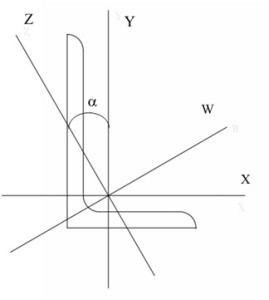During our July 2015 session, Flexural Design of Single Angle Members, Whitney McNulty, PE, SECB, from BL Companies, addressed the fundamental challenges inherent to designing single angle members, in which the geometric and principal axes do not align. He also offered a rule of thumb when considering lateral bracing for an equal leg single angle under flexure.

Graphic provided by Whitney McNulty
In the Figure shown to the right, the geometric axes of the member are represented by X and Y, and the principal axes are represented by W and Z. Loading a single angle usually occurs about the geometric axes, but a single angle without lateral torsional restraint naturally bends about its principal axes, rather than its geometric axes. In addition, the strength of an angle is typically controlled by section properties that relate to its principal axes. The AISC Steel Manual provides section properties related to the geometric axes of the member. However, principal axis section properties must be calculated, or they can be found in the AISC Shapes Database, or Appendix B of Whitney’s publication, Single Angle Design Manual.
Whitney explained that although the Steel Manual provides equations that let us analyze the strength of equal leg single angles in flexure using the geometric axis section properties, we can’t rely on the deflections that we calculate when using the geometric axis section properties. Because the angle is really bending about its principal axes, the vertical deflection we get if we use the geometric axis moment of inertia needs to be increased by a factor of 1.56. The angle also moves laterally equal to 0.94 times the vertical deflection calculated using the geometric axis moment of inertia. The ratio of these two deflections, lateral to vertical, is 60%. Thus, Whitney explained that it would take 60% of the vertical load to laterally restrain an equal leg single angle to only move in the vertical direction, which is what we assume when we say the angle has full lateral torsional bracing. This is quite a large force, so Whitney suggested that normally we should consider equal leg angles to be laterally unbraced when we are using the geometric axis bending equations. He also reminded the group that geometric axis bending cannot be used with unequal leg angles unless they have full lateral torsional restraint.
This rule of thumb was presented as a poll question during the session, and further discussion can be found in the video clip below.
